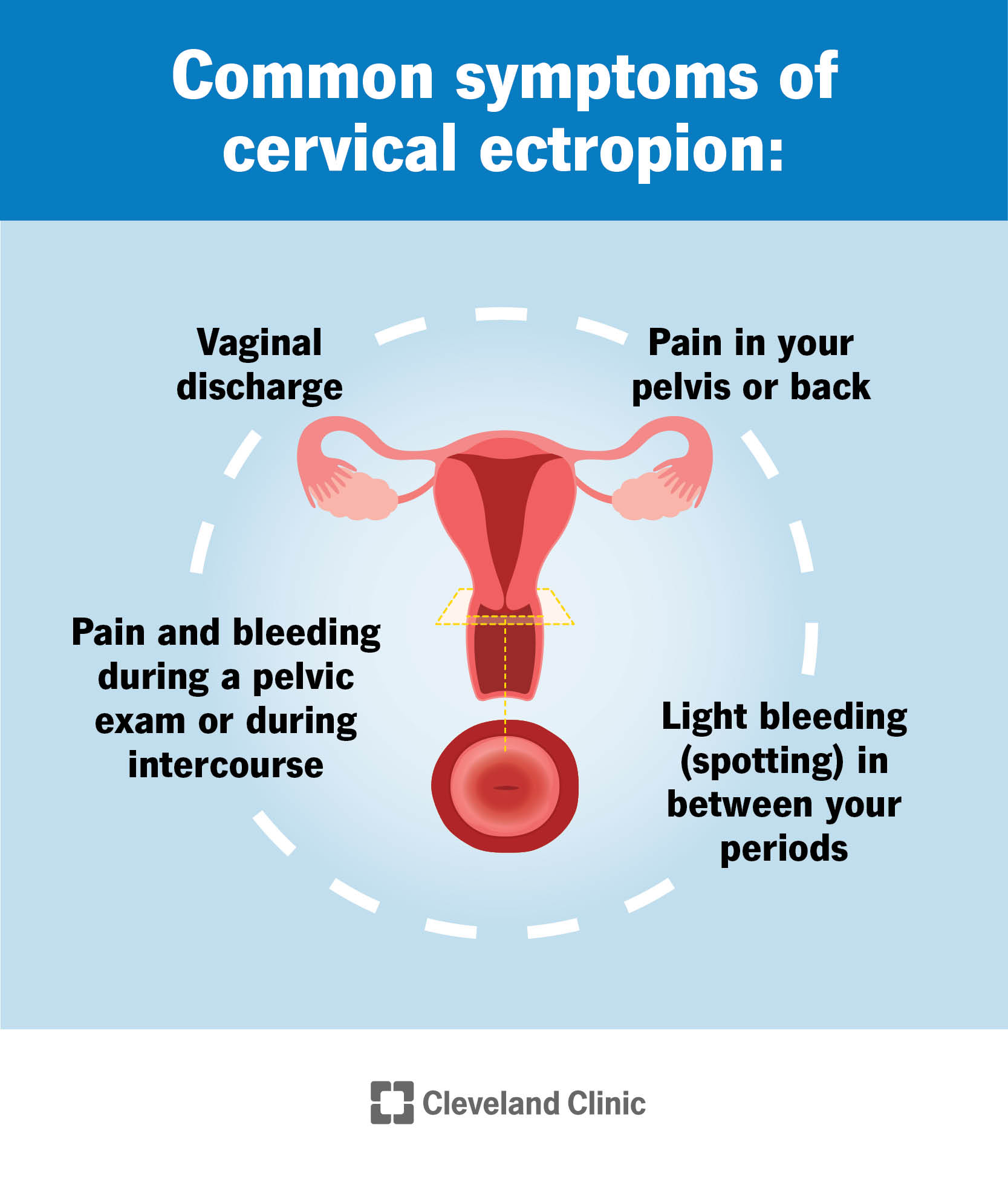With cervical ectropion, the glandular cells on the inner portion of your cervix become visible from the outside. Cervical ectropion is a harmless variation, or difference, in the appearance of your cervical cells. It rarely causes symptoms and isn’t cause for concern.
Advertisement
Cleveland Clinic is a non-profit academic medical center. Advertising on our site helps support our mission. We do not endorse non-Cleveland Clinic products or services. Policy
Cervical ectropion means that the cells inside your cervix are visible outside of your cervix. Cervical ectropion isn’t a concerning condition. Instead, it’s a harmless variation — or difference — in the way that cervical cells may appear.
Advertisement
Cleveland Clinic is a non-profit academic medical center. Advertising on our site helps support our mission. We do not endorse non-Cleveland Clinic products or services. Policy
The outer and inner parts of your cervix consist of two types of cells.
Cervical ectropion occurs when parts of your cervix turn inside out so that your healthcare provider can see the glandular cells outside of your cervix — as you might see the inside of a flower bud when a flower blooms.
Sometimes, cervical ectropion is called cervical erosion, but this name is misleading. Cells don’t “erode” with cervical ectropion. Instead, the cervix “everts” or turns inside out so that the glandular cells that cover the inner portion of your cervix are visible from the outside.
Cervical ectropion is most common if you're of reproductive age. Related, if you've gone through menopause, you'll rarely have cervical ectropion.
Cervical ectropion affects you if your body is producing high levels of estrogen. You’re more likely to have cervical ectropion during:
Advertisement
You’re more likely to have cervical ectropion if you’re taking estrogen-progestin contraceptives or if your cervix was torn during childbirth.
Cervical ectropion is common. Anywhere from 17% to 50% of women likely have this harmless variation.

Cervical ectropion doesn’t usually cause symptoms. Instead, your healthcare provider may notice signs of cervical ectropion during a routine pelvic exam or Pap smear. Still, since it’s a harmless condition that isn’t cause for concern, your provider likely won’t mention if you have it.
In rare instances, cervical ectropion may cause symptoms. These symptoms may be signs of cervical ectropion, but it’s more likely that they’re associated with other conditions.
Cervical ectropion may be a harmless variation, but the conditions that most often cause these symptoms warrant a visit with your healthcare provider. Contact your provider if you notice any of these symptoms so that you can receive a correct diagnosis.
Cervical ectropion is considered a benign, or harmless, condition. Having cervical ectropion only means that the glandular cells inside your cervix are visible from the outer part of your cervix.
You may have been born with cervical ectropion. Likely, the glandular cells are visible because of your body’s exposure to estrogen. You’re more likely to have it when your estrogen levels increase.
Cervical ectropion often doesn't cause symptoms, so you may not know you have it unless your healthcare provider discovers it incidentally during an unrelated test or procedure. These tests may include:
It’s important to remember, though, that cervical ectropion isn’t an abnormal finding, and it’s not something that your provider checks for during a test or procedure. Your provider probably won’t mention that you have cervical ectropion even if you do have this variation.
Cervical ectropion often doesn’t require treatment. In rare instances, if you have cervical ectropion and are experiencing frequent vaginal discharge or spotting, you may benefit from medicines to provide symptom relief. Your provider may prescribe boric acid suppositories to lessen symptoms.
Advertisement
More intensive procedures can destroy cells that may be causing symptoms. These include:
Again, however, you likely won’t need treatment for cervical ectropion. It’s much more likely that your symptoms are related to another issue that requires treatment based on the specific diagnosis.
Don’t be concerned if your healthcare provider mentions that you have cervical ectropion. It’s just a common variation in the way that the cells in your cervix grow. It isn’t a sign of disease.
You can’t prevent cervical ectropion, but you shouldn’t worry if you have it. It's a harmless condition that isn’t associated with or caused by more concerning conditions.
You should see your provider if you experience any unusual symptoms, such as abnormal bleeding, pain during intercourse or afterward, or pain in your pelvic area that’s unrelated to menstrual cramps. These symptoms may be related to cervical ectropion. It’s more likely that your symptoms are related to a condition other than cervical ectropion that requires your provider’s care.
Advertisement
Don’t be concerned if you learn that your cervical cells from the inner part of your cervix are visible from the outside. Don’t be alarmed by the word “cervical ectropion.” Think of it as a variation in how your cervical cells appear instead of a scary condition. It isn’t associated with any disease-related risks.
Advertisement
From routine pelvic exams to high-risk pregnancies, Cleveland Clinic’s Ob/Gyns are here for you at any point in life.

Last reviewed on 05/20/2022.
Learn more about the Health Library and our editorial process.